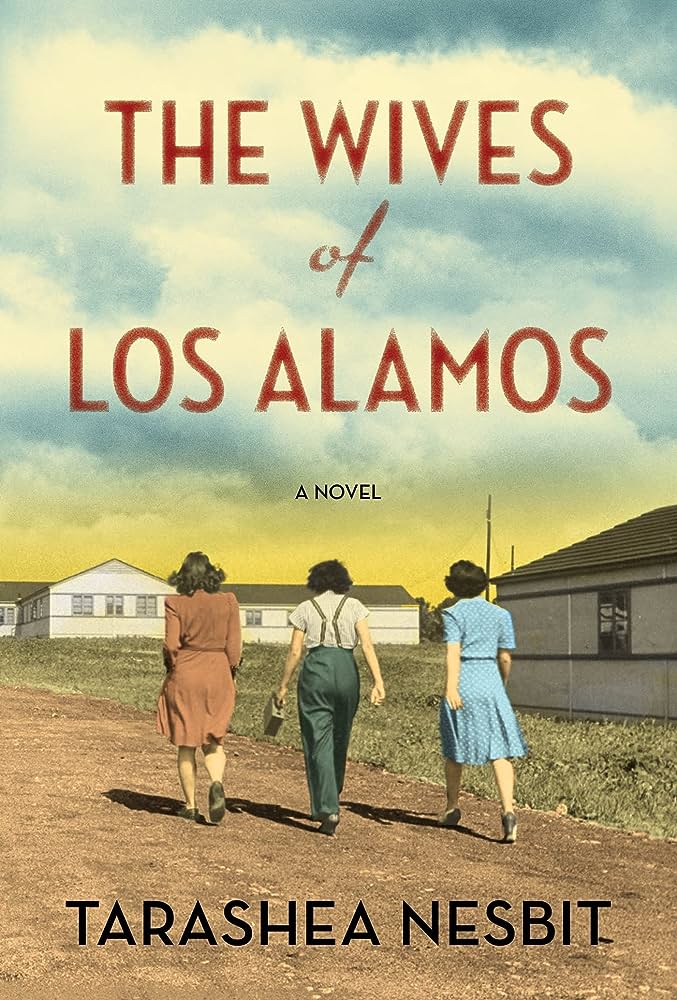“What work do wives do? They understand male scientific and military might and destruction from the perspective of the unwitting receiver (or observer or supporter), which is the role most of us play.”

In The Wives of Los Alamos, Tarashea Nesbit’s 2014 novel about the development of the atomic bomb, we are immersed in the words, work and worries of over 600 wives in a secret town in New Mexico.
Writing in the first-person plural, Nesbit examines the role of wives in Los Alamos. These diverse women, linked briefly through location and matrimonial role, discuss everything they see and do in Los Alamos. They are not allowed to learn about the top-secret work done by their husbands in the Tech Area.
The limits to women’s vision map this secret town as a part of wives’ work. They set up households as they are built, relish hard-to-procure bathtubs, cook meals with unsatisfactory stoves, get pregnant, raise children, throw parties and volunteer.
They also find paid labor. “Now here there were jobs for us. The Director came to our house and asked us to ‘Please think about working while you’re here, it would be a good career opportunity.’” Some wives worked as secretaries and scientists, others as mail carriers and librarians. Some chose not to because they had enough already on their hands, or they would be underpaid and demeaned.

In the chapter “Women’s Army Corps,” we observe the female soldiers working tirelessly, “their voices carried as they marched from the campfire to their dorm door and into their rooms.” We also learn of the scores of workers who arrived every day to clean, cook and care for the homes of Los Alamos.
What work do wives do in this book? They understand male scientific and military might and destruction from the perspective of the unwitting receiver (or observer or supporter), which is the role most of us play.
There are only two women in ‘Oppenheimer‘ with notable speaking roles. … But any potential power in these roles shifts at the whims of men.
Only a rare few of us—heroes in the singular—design weapons, laws or algorithms that rule the rest. Men like Oppenheimer, Bohr, Einstein, Musk, Zuckerberg, Biden and Nolan are examples of this.
What work do women do in Oppenheimer, a more recent attempt to understand this same history, albeit from the perspective of husbands? Nolan’s depiction of atomic history is credited to one man. We sometimes see women and wives doing some of the things expressed by Nesbit, albeit as a backdrop.

There are only two women in Oppenheimer with notable speaking roles—a fair enough reversal of Nesbit’s vision: His world is made of men, working, talking, building, destroying, worrying. Emily Blunt and Frances Pugh do great work with very few words spoken. The women’s work in Oppenheimer, in this case meaning their function, is sexual: as muse, mistress, mama. But any potential power in these roles shifts at the whims of men. The real performances of this film—science, law, politics, violence, espionage—are seen and spoken without them.
In Barbie, a contemporaneous cinematic world, women can only work equally in a fantasy. The film has been taken to task for how frequently Barbies and Kens say “patriarchy,” but what other word depicts locales where one gender can fill every scene with both bombast and bomb threats?
In 2022’s Women Talking, Sarah Polley (making good work of the words of Miriam Toews) uses a similar device: women’s words. She uses the talk of wives to paint the destructive drive of men—men who must, it seems, mix their labor with sex, domination and diminishment, only then to uncritically engender unethical forces of destruction.
While Oppenheimer is filled with the man’s words of self-criticism about the bomb, all its men are less self-aware about the associated bombast. Thus, we still need women’s and wives’ words, and work, to build out and keep functioning the places for being.
Up next:
U.S. democracy is at a dangerous inflection point—from the demise of abortion rights, to a lack of pay equity and parental leave, to skyrocketing maternal mortality, and attacks on trans health. Left unchecked, these crises will lead to wider gaps in political participation and representation. For 50 years, Ms. has been forging feminist journalism—reporting, rebelling and truth-telling from the front-lines, championing the Equal Rights Amendment, and centering the stories of those most impacted. With all that’s at stake for equality, we are redoubling our commitment for the next 50 years. In turn, we need your help, Support Ms. today with a donation—any amount that is meaningful to you. For as little as $5 each month, you’ll receive the print magazine along with our e-newsletters, action alerts, and invitations to Ms. Studios events and podcasts. We are grateful for your loyalty and ferocity.





